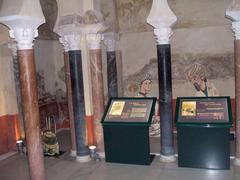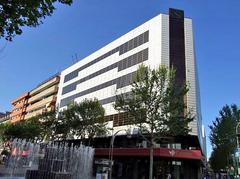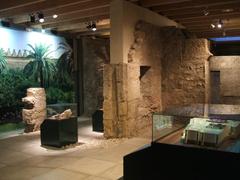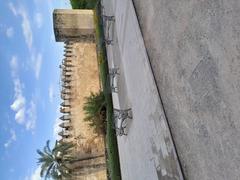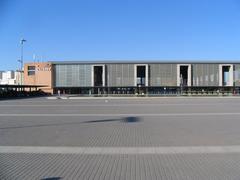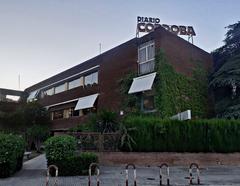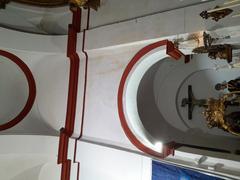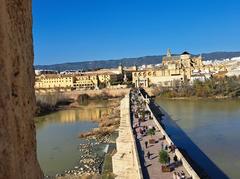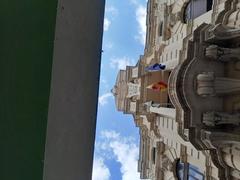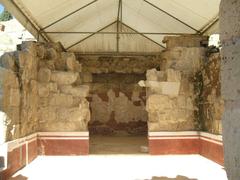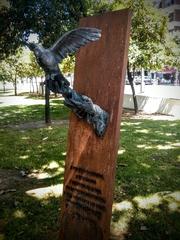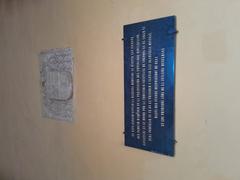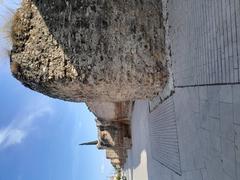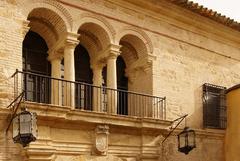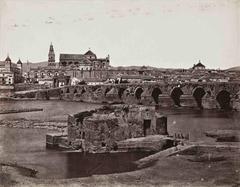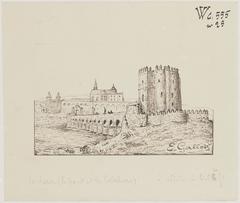Torre De Linares: Visiting Hours, Tickets, and Comprehensive Guide to Córdoba’s Historical Sites
Date: 14/06/2025
Introduction
Torre De Linares, perched on the northern outskirts of Córdoba, Spain, is a remarkable testament to the region’s layered history. Fusing Islamic military architecture with Christian religious heritage, this iconic site originated as a Muslim watchtower in the era of Al-Andalus and was later transformed into the Sanctuary of Nuestra Señora de Linares during the Christian Reconquista. Today, Torre De Linares stands as a serene yet profound destination that appeals to history enthusiasts, cultural travelers, and spiritual pilgrims alike.
This comprehensive guide explores Torre De Linares’ historical significance, architectural evolution, visitor information (including up-to-date visiting hours and ticketing), accessibility insights, travel tips, and the broader cultural context of Córdoba’s UNESCO World Heritage landscape. Whether you are seeking to immerse yourself in Andalusian heritage, attend vibrant local festivals, or simply enjoy panoramic views away from the city’s crowds, Torre De Linares offers a unique window into the multifaceted past and present of southern Spain.
For the most current updates and official announcements, visit the Sanctuary’s website or the Córdoba tourism board.
Table of Contents
- Visitor Information
- Historical Background of Torre De Linares
- Cultural and Religious Significance
- Notable Figures and Events
- Architectural Features and Site Layout
- Frequently Asked Questions (FAQ)
- Visitor Tips and Nearby Attractions
- Cultural Heritage and Local Traditions
- Sustainability and Responsible Tourism
- Conclusion
- References
Visitor Information
Visiting Hours and Tickets
- Opening Hours: Tuesday to Sunday, 10:00 AM – 6:00 PM. Closed on Mondays and certain public holidays.
- Admission: Free entry; donations are appreciated to support preservation.
- Guided Tours: Available on weekends and by prior arrangement. For details and bookings, consult the official sanctuary website or Córdoba tourism office.
- Note: For interior visits and special events, check for seasonal updates or restoration closures.
How to Get There
- By Car: Accessible via the A-4 highway, with parking available nearby.
- Public Transport: City buses connect the center of Córdoba to the sanctuary; taxis are a convenient alternative.
- Location: Northern outskirts of Córdoba, set on the lower slopes of the Sierra Morena.
Accessibility
- Partial Wheelchair Access: Some areas, including the tower, have limited accessibility due to historic architecture. Contact the site in advance for specific assistance.
- Terrain: Expect cobblestone paths and uneven ground—sturdy footwear is recommended.
Guided Tours and Nearby Attractions
- Guided Tours: Led by knowledgeable local guides, providing historical and cultural context.
- Nearby Sites: Mezquita-Catedral, Alcázar de los Reyes Cristianos, Roman Bridge, and the UNESCO-listed historic center.
Historical Background of Torre De Linares
Origins and Early History
Torre De Linares traces its origins to the medieval period, initially constructed as a Muslim watchtower for strategic surveillance during Al-Andalus. After the Christian conquest of Córdoba in 1236 by King Ferdinand III of Castile, the site was transformed into a sanctuary dedicated to Nuestra Señora de Linares. This marked the creation of the first extramural sanctuary in the city, symbolizing both military and spiritual transformation (UNESCO).
Architectural Evolution
The tower’s robust masonry, narrow archer windows, and commanding height reflect its military purpose. Over centuries, Christian additions—such as the hermitage and annexes—were integrated, resulting in a harmonious blend of Islamic and medieval Christian styles (UNESCO Urban Heritage Atlas). Ongoing preservation efforts ensure the tower remains a prominent feature of Córdoba’s historic landscape.
Cultural and Religious Significance
Marian Devotion and Pilgrimage
The sanctuary is a revered center for Marian devotion, venerated by King Ferdinand III and his army. The “Virgen Conquistadora y Capitana,” or Virgin of Linares, is associated with Christian victory and protection during the Reconquista. An annual pilgrimage, or romería, continues to draw worshippers from across the region, reflecting centuries-old tradition and community identity.
Symbol of the Reconquista
Torre De Linares stands as a living emblem of the Reconquista, commemorating both the Christian reclamation of Córdoba and the enduring interplay of cultures that have shaped Andalusia.
Notable Figures and Events
- King Ferdinand III of Castile: Instrumental in the site’s transformation and a central figure in Spain’s unification.
- Hermandad de la Virgen de Linares: The religious fraternity that maintains the sanctuary and organizes annual pilgrimages.
- Local History: The tower has witnessed both conflict and peace, serving as a military outpost and religious center.
Architectural Features and Site Layout
- Islamic Elements: Narrow windows, solid stonework, and defensive design.
- Christian Additions: Hermitage, religious iconography, and additional annexes.
- Views: Elevated position provides scenic panoramas of Córdoba and the Sierra Morena.
Frequently Asked Questions (FAQ)
Q: What are Torre De Linares’ visiting hours?
A: Tuesday to Sunday, 10:00 AM–6:00 PM. Closed Mondays and public holidays.
Q: Is there an entrance fee?
A: No. Entry is free; donations are encouraged.
Q: Are guided tours available?
A: Yes, on weekends and by appointment.
Q: Is the site wheelchair accessible?
A: Partially—contact the sanctuary for details.
Q: How do I get there from Córdoba’s center?
A: By car (A-4 highway), bus, or taxi.
Visitor Tips and Nearby Attractions
- Combine Visits: Explore Torre De Linares alongside the Mezquita-Catedral and Alcázar de los Reyes Cristianos (Seville City Guide).
- Best Timing: Spring and autumn offer pleasant weather and vibrant festivals (Turismo de Córdoba).
- Respect Heritage: As a UNESCO site, please follow guidelines to preserve the monument (UNESCO).
- Local Culture: Sample Cordoban cuisine, visit artisan shops, and engage with local traditions (My Path in the World).
Cultural Heritage and Local Traditions
Historical and Multicultural Influences
Córdoba’s history is a tapestry of Roman, Visigothic, Islamic, Jewish, and Christian cultures. Torre De Linares and its region showcase this multicultural legacy through architecture, festivals, and daily customs (Spain.info). The coexistence of diverse communities is celebrated in museums, festivals, and local narratives (Bea Adventurous).
Annual Festivals
- Fiesta de los Patios: UNESCO-listed festival in May with flower-filled courtyards (Andalucia.com).
- Feria de Córdoba: Late May fair with music, dance, and local cuisine (Visit Andalucia).
- Noche Blanca del Flamenco: June flamenco festival (Bandsintown).
- Semana Santa: Holy Week processions (Spain.info).
Gastronomy and Crafts
Enjoy regional dishes like salmorejo and rabo de toro, and browse local markets for Andalusian crafts—leatherwork, ceramics, and silver filigree (Bea Adventurous).
Sustainability and Responsible Tourism
Torre De Linares relies on visitors to help preserve its fragile heritage. Please avoid damaging the site, stay on marked paths, and support local businesses. Responsible tourism ensures that future generations can enjoy this historical treasure (Travelpander).
Conclusion
Torre De Linares remains a distinguished, contemplative jewel within Córdoba’s historical landscape. Blending Islamic and Christian influences, it offers visitors a unique journey through Spain’s past. Its accessibility, free entry, and engaging guided tours make it an ideal addition to any cultural itinerary. Surrounded by vibrant festivals and culinary delights, Torre De Linares invites you to experience the living heritage of Andalusia.
Stay informed by consulting official sources and download the Audiala app for exclusive guides and travel tips. Embrace responsible tourism and enrich your journey by exploring both the tower and Córdoba’s wider cultural offerings.
References
- Sanctuary’s official website
- Córdoba Tourism Board
- Andalucia.com: Córdoba City Guide
- Bea Adventurous: Complete Guide to Córdoba
Plan your visit today—uncover the enduring legacy of Torre De Linares and explore the wonders of Córdoba’s historic heart!
